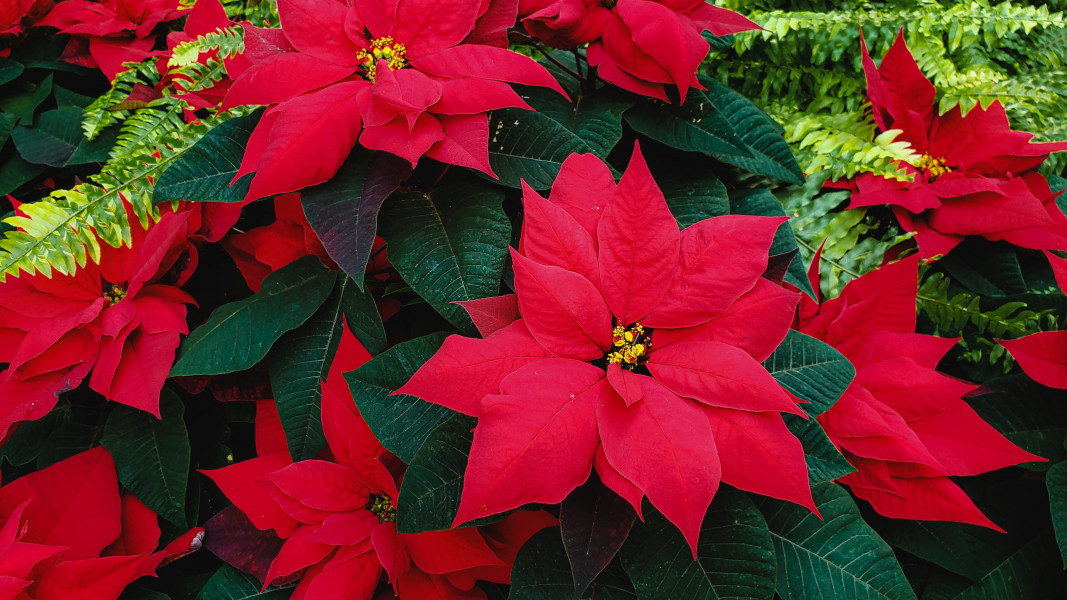How to Choose a Poinsettia?
When choosing a poinsettia plant, make sure the leaves are dark green. Fallen or faded leaves indicate a lack of care, lack of water or root problems. The colorful flowers (bracts) of the plant (red, pink, white) should be proportionally located on the remaining leaves and root ball.
Take Care of the Poinsettia
Be sure that the plant is well packaged when you buy it outside, because during your trip home it is exposed to low temperatures and even for a short time can hurt the leaves and bracts, and even freeze. In no case do not leave it for long periods in sub-zero temperatures! Unpack the plant as soon as possible, as the leaves may start to fall very quickly.
Place the flower next to the window in direct sunlight, but in no case should the leaves touch the glass. Do not place it near radiators and other heating appliances!
Keep in mind that poinsettias are tropical plants and they are grown in greenhouses where temperatures are constant - from 59°F to 70°F, so if possible, maintain these temperatures!
Do not place the plant in a stream (open windows, doors, etc.).
Watering
Water sparingly only when the topsoil dries. If you do not water enough, the lower leaves will start to fall off, and so begins the loss of the entire leaf mass.
When watering, do it abundantly, and after a while it is necessary to discard excess water from the saucer. If you water excessively and leave the plant to soak in water, the lower leaves will turn yellow and fall off.
Fertilization
If you keep the poinsettia for a long time, feed with soluble fertilizer once or twice a month.
How to Keep the Poinsettia Until Next Christmas?
Late in winter and early spring
The poinsettia has perennial flowers - its bracts will remain brightly colored for several months, even after the fall of the green part.
During this time, side shoots will begin to develop. To have a well-formed plant for next year, you need to reduce the height to 4 in. Pruning is done in February - March. It will stimulate the formation of new leaves.
Grow the plant next to a sunny window at a temperature between 59°F and 70°F.
Late spring and summer
If the plant is too large, transplant it into a larger pot. Once the danger of spring frosts has passed and night temperatures exceed 50 °F, you can plant the poinsettia together with the pot and outside. Remember that the plant may need to be watered more often. Between July 15 and August 1, cut all the shoots to about 4 in, leaving one to three old leaves.
During autumn
Remove the poinsettia indoors before the first frost (around September 15) to avoid injury from cooling. This happens when temperatures are below 45 °F.
It is recommended to fertilize every two weeks.
To begin flowering, you need to keep the plant in complete darkness between 5pm and 8am, every day from late September to early December.
The temperature must remain between 59°F and 70°F. Night temperatures above 73°F can slow down or interfere with flowering.
How To Take Care of Poinsettias by Month?
January
After flowering (after the red leaves fall off), cut 4 in from the roots and place for 2 months in a cooler room with sparse watering. This is the obligatory "holiday" of the Christmas star, after which we will do magic for waking up and new flowering.
March
Transplant Poinsettia in a larger pot and in a well-structured peat substrate. This will "wake it up" and it will begin to expand its roots in its new, larger home. Gradually start watering and nourishing the plant regularly.
April
At the end of spring you can take the Christmas star out on the balcony or in the yard and watch it as an outdoor plant until autumn. Continue watering and nourishing it regularly, and occasionally clean it of dried leaves.
September
It's time to put the Poinsettia warmer - on a glazed balcony or, if autumn is cold, in a room.
October
In the autumn the Poinsettia begins to prepare for a new flowering. The most important thing during this period is the so-called "Light mode". Poinsettia is a short-day plant and to ensure proper flowering conditions, from the end of October, in the evening, move the pot to complete darkness (in the closet, closet or other dark place) or cover it with a thick box. Take it back to daylight in the morning.
Alternate this mode until Christmas, when the Poinsettia will delight you with its colors. Continue to nourish it, especially during the period of flower bud formation and during flowering. Fertilizers for flowering plants are currently suitable. This will help her bloom even richer and more beautiful!

